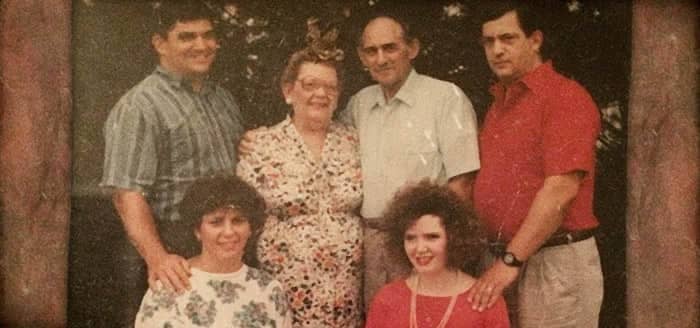Janet Stanton Schnitzer Remembers Her Father’s Mesothelioma Battle

Walter Stanton can be remembered as a hard worker and huge family man. He was dedicated to his work as a machinist and served as a U.S. marine, working in the Civil Air Patrol. Beyond work, he was a doting husband and dad.
“He was very involved as a scout leader for both my brothers. He and my mom had a rare and devoted marriage,” His daughter, Janet, recently explained to the Mesothelioma + Asbestos Awareness Center. “He was very close with his parents and siblings. Both my sister and I believed we were his most prized possessions!”
Janet remembers wonderful nights with the family. Her mom would have dinner on the table when he got home from work, and they’d all eat together. She recalls being “so spoiled” she would even sit on his lap at the dinner table to eat her meal.
“He belonged to a bowling league and once again, being so spoiled, he didn’t mind me tagging along on his guys’ night out. Wherever he went, I wanted to go, too!” Janet said.
But in 1993, the family’s world came crashing down when Walter was diagnosed with mesothelioma.
Facing Occupational Hazards
Walter Stanton was a dedicated machinist for his company. He first started working for them in his home state, New Jersey, and transferred to plants in various states before ending up in Delaware.
Unfortunately, his commitment as a machinist likely meant prolonged exposure to asbestos. Being a machinist can involve many different tasks and often involved handling asbestos-containing materials and products. Later in his career, Walter was transferred to work on photo products, which were innovated to be able to withstand harsh environments and extreme temperatures.
Asbestos has long been used in a wide range of products because it’s very durable and able to resist fire and extreme heat. Asbestos can also withstand a lot of chemicals and potential breakdowns. The mineral can be found in many older buildings and homes since it was very popular for construction materials, as well as some consumer products. Based on his field of work and changing environments, it’s likely Walter was often exposed to asbestos from the products he worked with and the buildings he worked in.
His company also worked with a huge variety of chemicals through their different products and offerings, so it’s likely Walter was exposed to many different toxins through his occupation. It’s estimated that about 17% of occupational injuries and illnesses stem from some kind of exposure. Asbestos exposure through work is actually fairly common, with estimates of 125 million people exposed on the job globally each year.
Walter could have also faced exposure to asbestos during his service as a marine. All the military branches used asbestos in a variety of applications, putting many at risk for exposure. Navy vessels especially had particularly high asbestos use, making veterans on these ships and anyone working in shipyards especially vulnerable to exposure.
A Devastating Diagnosis
“I had just turned 34 when he was diagnosed,” Janet reflected. “I had a three year old daughter, Alessandra; a one year old daughter, Samantha; and was pregnant, due in December. My sister was pregnant with her first child.”
Janet said her dad’s illness started with a cough that May. Mesothelioma typically starts showing nonspecific symptoms that can be mistaken for more minor ailments. The disease can take decades after exposure to begin showing these symptoms, so mesothelioma can take weeks or even months to properly diagnose.
The family learned Walter had mesothelioma in the lining of his chest about a month after his cough started. Pleural mesothelioma occurs when the tumors grow in the pleura, the thin membrane lining of the lungs and chest wall. It is the most common form of mesothelioma, but still has a relatively poor prognosis. Patients are typically given anywhere from one year to 21 months to live because the disease is so aggressive and difficult to treat.
After his diagnosis, Walter was placed in hospice care. For many mesothelioma patients, by the time the disease is properly diagnosed, it has already advanced to a later stage. At this point, many patients do not have many curative treatment options and instead seek a palliative care plan to help relieve their symptoms.
Walter died at home in November, just about 5 months after his diagnosis. Losing their loving dad was beyond heartbreaking for the family.
“Mesothelioma is a horrible, incurable disease a person gets at no fault of their own. I hate it with all my heart and soul!” Janet insisted. “My son was born two weeks after my dad died, and mesothelioma shattered my faith in God for a very long time.”
Repairing a Broken Heart
It was very difficult for the family to recover from losing Walter, and the loss will always be felt profoundly. Though Janet has fibromyalgia, which limits her activities, she hopes to help raise awareness for this rare disease and asbestos.
Asbestos is still not banned in the United States or about 70% of the world today, despite being known as a carcinogen. More recently, the United States has started making some positive movements that could help ban the toxin. Last year, the Frank R. Lautenberg Act was passed, giving the Environmental Protection Agency the authority to investigate the risk of 10 chemicals, including asbestos.
Though it would still take years to reach a ban, advocates are hopeful this important work can continue unhindered under the new administration. Until a ban finally occurs, Janet hopes others will realize the dangers of asbestos and help prevent mesothelioma in their loved ones.
“I miss him every single day and I regret that my children didn’t know him,” Janet said. “I am trying my hardest to live a life he would be proud of and for my children to know him in all ways I can control.”